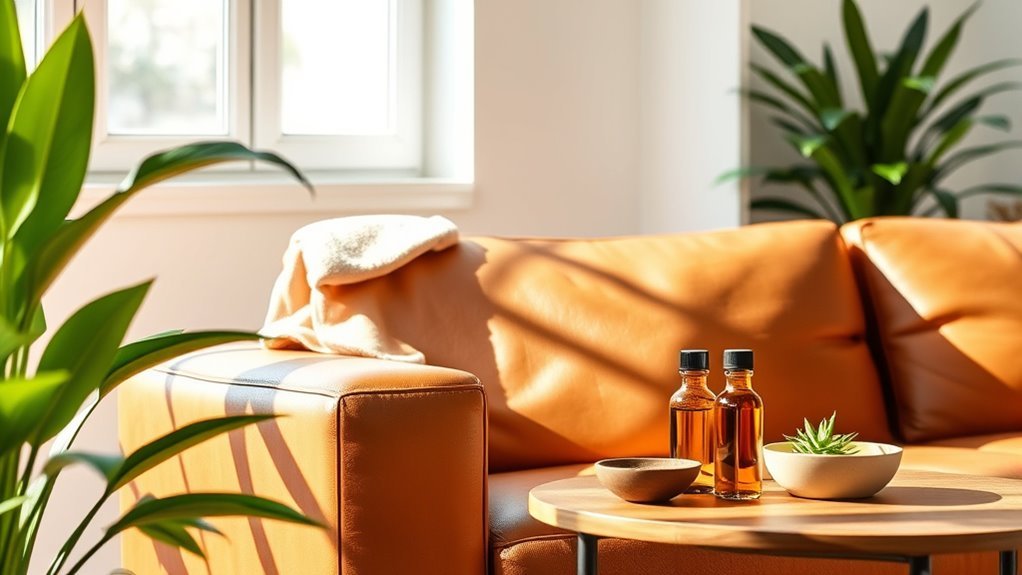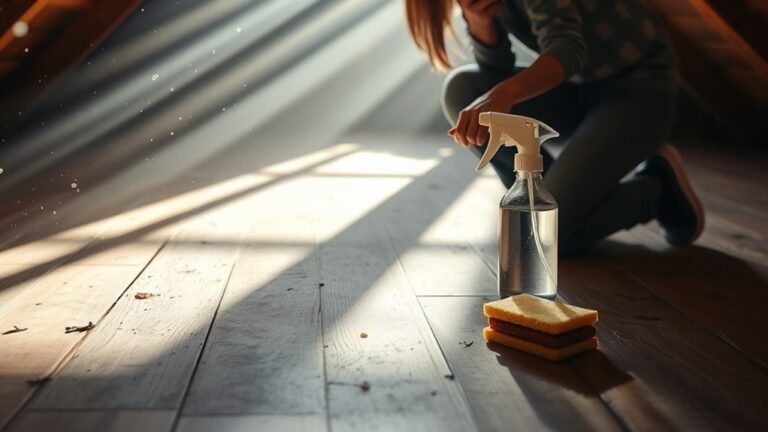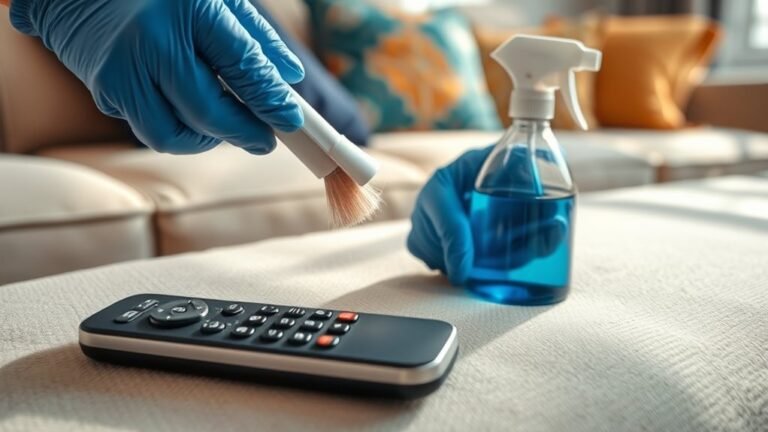Spring Cleaning Guide for Sofa
For your spring sofa cleaning, start by checking its material and removing cushions for vacuuming seams and crevices with an upholstery brush. Spot clean stains quickly using mild, eco-friendly solutions tested on hidden areas. Fabric sofas usually need gentle soap; leather requires special conditioners. Regular deodorizing helps fight allergens and prolongs life. Protect your sofa with washable covers and rotate cushions often. Stick to these basics, and you’ll find ways to keep your sofa fresh and inviting all year long.
Assessing Your Sofa’s Cleaning Needs

How do you know when your sofa needs a deep clean? Start by considering your sofa materials—leather, microfiber, or cotton each react differently to dirt and stains. If your sofa feels sticky, smells musty, or has visible stains, it’s a clear sign it’s time for a thorough clean. Your cleaning frequency should depend on how often you use it and whether pets or kids share the space. A heavily used cotton sofa might need deep cleaning every three to six months, while leather can often go longer with regular maintenance. Paying attention to these details lets you maintain your sofa’s freedom from grime and keep your living space feeling fresh and open, just the way you like it.
Gathering Essential Cleaning Supplies
To tackle sofa cleaning effectively, you’ll need a handful of essential supplies ready before you start. First, gather versatile cleaning tools like soft brushes, microfiber cloths, and a handheld vacuum attachment. These will help you reach every corner without damaging your sofa’s fabric. Next, opt for eco friendly products to keep your space fresh and chemical-free. Look for plant-based upholstery cleaners or make your own using natural ingredients like vinegar and baking soda. Having a spray bottle handy makes applying these solutions easier and more controlled. Don’t forget gloves to protect your hands, especially if you’re using any concentrated cleaners. With these smart supplies, you’ll feel empowered to clean your sofa thoroughly while staying true to your values and love for freedom.
Vacuuming Techniques for Deep Cleaning

Vacuuming your sofa thoroughly can make a huge difference in removing dust, crumbs, and pet hair that settle deep within the cushions. To truly liberate your sofa from hidden dirt, use vacuum attachments and upholstery brushes designed for deep cleaning. They reach places your hands can’t, ensuring every nook is new.
Here’s how to maximize your vacuuming freedom:
- Detach cushions to access seams and crevices
- Use upholstery brushes for gentle yet effective cleaning
- Employ crevice tools to reach tight spots
- Vacuum slowly to lift embedded particles
- Regularly empty the vacuum to maintain suction power
Embrace these techniques, and your sofa will feel lighter, cleaner, and free from trapped debris, giving you a revitalizing space to relax.
Spot Cleaning Common Stains
When you spot a stain on your sofa, the first step is to figure out what kind it is. Different stains need different cleaning solutions to work effectively. Knowing the right technique can make all the difference in getting your sofa looking fresh again.
Identifying Stain Types
How can you quickly tell what type of stain you’re dealing with on your sofa? Knowing stain identification is key to preserving your freedom from stubborn marks. Start by considering the fabric types—natural fibers react differently than synthetics. Next, observe the stain’s color, texture, and smell. Here’s a quick guide to help you pinpoint common stains:
- Greasy spots often feel oily and attract dirt.
- Ink stains are usually dark and sharp-edged.
- Food and drink spills vary in color and may have a sticky residue.
- Pet stains might have a distinct odor and discoloration.
- Mold or mildew appears fuzzy with a musty smell.
Recognizing the stain type empowers you to act swiftly and protect your sofa’s freedom from permanent damage.
Effective Cleaning Solutions
Although stain types vary, choosing the right cleaning solution is essential to avoid worsening the damage. You want something that’s effective but also gentle on your sofa and the environment. Eco friendly solutions are a great choice—they clean well without harsh chemicals that can harm your health or the planet. Homemade cleaners, like a mix of vinegar, baking soda, and water, offer a simple yet powerful alternative. They’re easy to prepare, cost-effective, and you can control exactly what goes into them. Just remember to test any cleaner on a hidden spot first to make sure it won’t discolor or damage the fabric. Using the right solution lets you tackle spots confidently while keeping your sofa fresh and safe for everyone.
Stain Removal Techniques
Since stains can set quickly, acting fast is key to effective spot cleaning. You want to keep your sofa looking fresh without feeling trapped by stubborn spots. Here are some stain prevention tips and DIY stain removers to help you regain control:
- Blot spills immediately with a clean cloth—never rub, to avoid spreading.
- Use a mixture of mild dish soap and water for most stains.
- For greasy marks, sprinkle baking soda first to absorb oil before cleaning.
- Test any DIY stain remover on a hidden area to prevent damage.
- Avoid harsh chemicals that can ruin fabric and limit your freedom to enjoy your sofa.
With these techniques, you’ll confidently tackle stains and keep your sofa inviting and carefree all season long.
Cleaning Fabric Upholstery Safely
Before you start cleaning your fabric upholstery, it’s important to check the manufacturer’s care instructions to avoid damaging the material. Different upholstery materials need specific cleaning techniques, so knowing what you’re working with helps you clean safely and effectively. Test any cleaner on a hidden spot to prevent discoloration or damage.
| Upholstery Material | Recommended Cleaning Technique |
|---|---|
| Cotton | Mild detergent, water, gentle scrub |
| Polyester | Mild soap, water, soft cloth |
| Linen | Dry cleaning or professional clean |
| Microfiber | Water-based cleaner, soft brush |
Caring for Leather Sofas

When you care for a leather sofa properly, it can maintain its rich look and durability for years. Embracing leather care means freeing yourself from constant worries about wear and tear. To keep your sofa looking its best, focus on these essential protection techniques:
- Regularly dust with a soft cloth to prevent dirt buildup
- Use a leather conditioner monthly to preserve suppleness
- Keep the sofa away from direct sunlight and heat sources
- Wipe spills immediately with a damp cloth to avoid stains
- Avoid harsh chemicals that can damage the leather surface
Refreshing Microfiber Upholstery
How do you keep your microfiber sofa looking fresh and clean without damaging its delicate fibers? Start by understanding microfiber benefits: its stain resistance and durability make it perfect for a carefree lifestyle, but it still needs gentle care. Vacuum regularly using a soft brush attachment to lift dirt without roughing up the fibers. For spots, dab with a mild soap solution and cold water—never soak it, as excess moisture can harm the fabric. Avoid harsh chemicals that strip microfiber’s protective layer. Let it air dry completely before using. Consistent upholstery maintenance like this preserves your sofa’s texture and color, allowing you to enjoy its softness and freedom from heavy cleaning routines. Keeping it simple guarantees your microfiber sofa stays as inviting as your lifestyle demands.
Deodorizing and Eliminating Allergens
Even if your sofa looks clean, it can harbor odors and allergens that affect your indoor air quality. To truly free your space, focus on effective deodorizing methods and allergen reduction. You deserve a fresh, healthy environment without feeling trapped by lingering smells or irritants. Try these steps:
- Sprinkle baking soda on cushions, let it sit, then vacuum to neutralize odors.
- Use a fabric-safe enzymatic cleaner to break down stubborn smells.
- Wash removable covers in hot water to eliminate dust mites and allergens.
- Vacuum your sofa thoroughly with a HEPA filter to capture fine particles.
- Air out your sofa regularly by opening windows or using a fan to circulate fresh air.
These simple actions help reclaim your freedom from hidden allergens and stale odors.
Maintaining Your Sofa Between Cleanings
Keeping your sofa fresh after deodorizing and removing allergens depends on regular care between deep cleanings. To enjoy your freedom from constant worry about dirt or stains, stick to a simple routine maintenance plan. Vacuum your sofa weekly to prevent dust buildup and fluff cushions to keep their shape. Using protective covers is a smart move—they shield your sofa from spills and pet hair, minimizing damage and extending its life. Choose covers that are easy to remove and wash, so you can quickly refresh your sofa’s look. Also, rotate cushions regularly to promote even wear. By staying consistent with these quick habits, you’ll keep your sofa inviting and clean without feeling tied down to complicated chores.
Frequently Asked Questions
How Often Should I Replace My Sofa Cushions?
You should consider your cushion lifespan when deciding on replacement frequency. Typically, sofa cushions last about 5 to 7 years, but it really depends on how often you use them and how well you care for them. If they’re sagging or losing support, it’s time to swap ’em out. Don’t feel stuck—keeping your cushions comfy guarantees your sofa stays a cozy spot where you can truly relax and enjoy your freedom.
Can I Use a Steam Cleaner on My Sofa?
Steam cleaning can certainly spruce up your sofa, but you’ve got to contemplate its upholstery materials carefully. Some fabrics soak up steam splendidly, while others might shrink or stain. If you’re craving a fresh, free feel without fuss, test a hidden spot first or check the manufacturer’s guide. That way, you’ll avoid any accidental damage and keep your comfy couch looking crisp and clean, ready for relaxing freedom.
What Are the Best Ways to Protect Sofas From Pet Damage?
To protect your sofa from pet damage, you’ll want to invest in furniture covers—they’re easy to remove and wash, keeping your sofa safe from scratches and spills. Choosing pet friendly fabrics like microfiber or leather can also help since they’re durable and resist stains. You can let your pets enjoy freedom without worry by setting up cozy spots with their own blankets nearby, too. This way, your sofa stays fresh and your pets stay happy.
How Do I Fix Minor Tears or Rips in Upholstery?
Imagine you’ve got a small tear on your favorite chair—don’t stress! Using upholstery repair techniques like fabric patching methods can save the day. You can cut a patch from matching fabric, secure it underneath the tear with fabric glue or sewing, and blend it in seamlessly. This approach keeps your furniture looking fresh and lets you keep enjoying your space freely, without rushing to replace or cover up those minor rips.
Are There Eco-Friendly Sofa Cleaning Products Available?
Absolutely, you can find eco-friendly sofa cleaning products that use natural cleaners, so you’re not stuck with harsh chemicals. If you want more freedom, try DIY solutions like a mix of white vinegar, baking soda, and water—these are gentle yet effective. They’re great for keeping your space fresh without harming the environment, letting you clean freely and responsibly without compromising your values or your sofa’s fabric.






